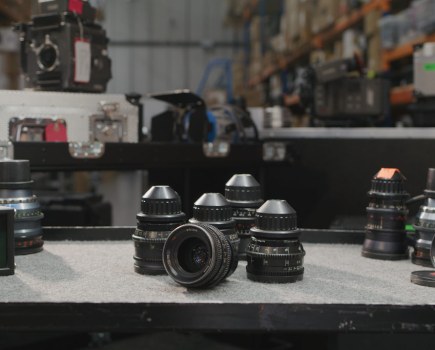A thought-provoking image of a fox whose woodland home has been eroded by industrial development wins through in prestigious wildlife competition, the British Wildlife Photography Awards 2023
Charlie Page has won the British Wildlife Photography Awards 2023 for his image of a fox moving through woodland being cleared for an industrial site (featured above). The 28-year-old photographer triumphed with a powerful image of a fox, roaming an area of woodland about to be cleared for development. ‘I knew this area was frequented by foxes, and I wanted to take an image with the industrial backdrop to show the devastation caused to this local woodland that the fox calls home,’ Charlie explained. ‘I hope that wildlife photographers aren’t faced with similar scenes in years to come.’ Neil also won the Urban Wildlife category.
RSPB Young British Wildlife Photographer of the Year 2023
Meanwhile, the RSPB Young British Wildlife Photographer of the Year 2023 was awarded to Billy Evans-Freke for his image of a tawny owlet resting in a tree (below). This award is supported by the RSPB with the aim of encouraging young people to get involved with nature. More than 13,000 images were submitted into this year’s competition, with amateur and professional photographers competing for the £5,000 grand prize.
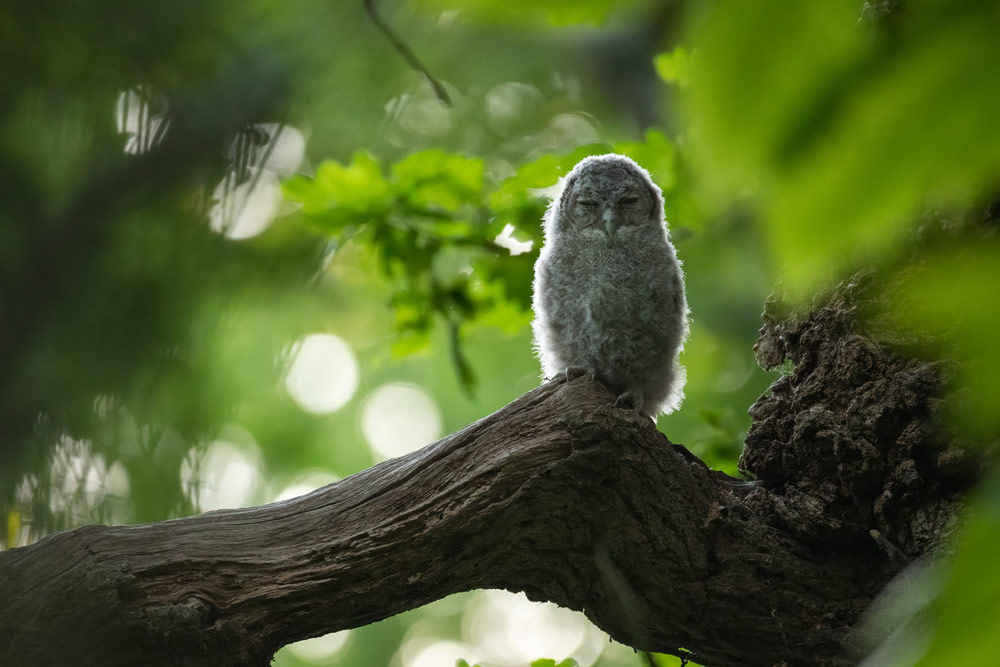
Billy Evans-Freke was named RSPB Young British Wildlife Photographer of the Year 2023. Credit: British Wildlife Photography Awards/Billy Evans-Freke
‘The talented photographers in this year’s competition have given us an exceptional window into Britain’s nature,’ says Will Nicholls, Director of BWPA. ‘It’s an important reminder of the wildlife and wild spaces that still remain in the UK, and are in need of our care and protection.’
Photographers competed in 10 different categories in the adult competition: Animal Behaviour, Animal Portraits, Botanical Britain, Black & White, British Seasons, Coast & Marine, Habitat, Hidden Britain, Urban Wildlife, and Wild Woods. A hardback book featuring all awarded images, with a foreword by Dame Judi Dench, is now available to pre-order. The 2024 competition is now open for entries, and invites photographers of all experience levels to submit their photos of Britain’s nature at its best.
Enjoy the other British Wildlife Photography Awards 2023 category winners
British Wildlife Photography Awards 2023, Animal Behaviour: Winner
Hitching a Lift, James Rodie

Credit: BWPA/James Rodie
Nikon D850 with Nikon 500mm f/5.6 lens. 500mm; 1/1,600th second; f/11; ISO 2,200.
‘The common toad migration to their spawning grounds can be a spectacular event to watch. As the large females make their way to the water, the smaller males approach them to try and ‘hitch a lift’. It can result in some amusing behaviour, as multiple males will often try to mount the same female. This image was captured just as one of the males tried to push
away another. It can be quite a difficult thing to photograph, as this is one situation when toads move surprisingly quickly.’
British Wildlife Photography Awards 2023, Animal Portraits: Winner
Sleeping with Dandelions, Lewis Newman
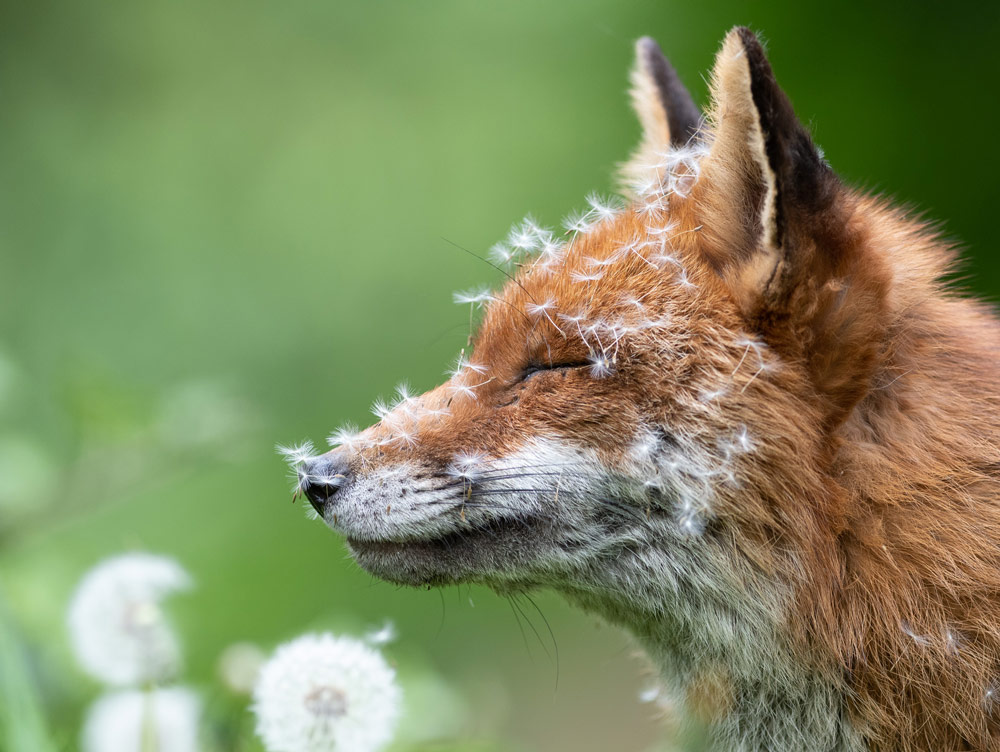
Credit: BWPA/Lewis Newman
Nikon D500 with Nikon 300mm f/2.8 lens. 300mm; 1/800th second; f/4; ISO 640.
‘After spending a lot of time with this particular vixen, she began to learn I was not a threat. This gave me some great photographic opportunities. I got to know her routine, and as the wildflowers began to grow, I would find her curled up amongst them. As the dandelions began to open there were a couple of days when she would wake up covered in them. Although she got used to my presence, if I were to move too fast or drop anything she would immediately leave. Later on in spring, I was blessed with her bringing her cubs to me and have watched them grow ever since.’
British Wildlife Photography Awards 2023, Botanical Britain: Winner
A Poet’s Lunch, by Matt Doogue
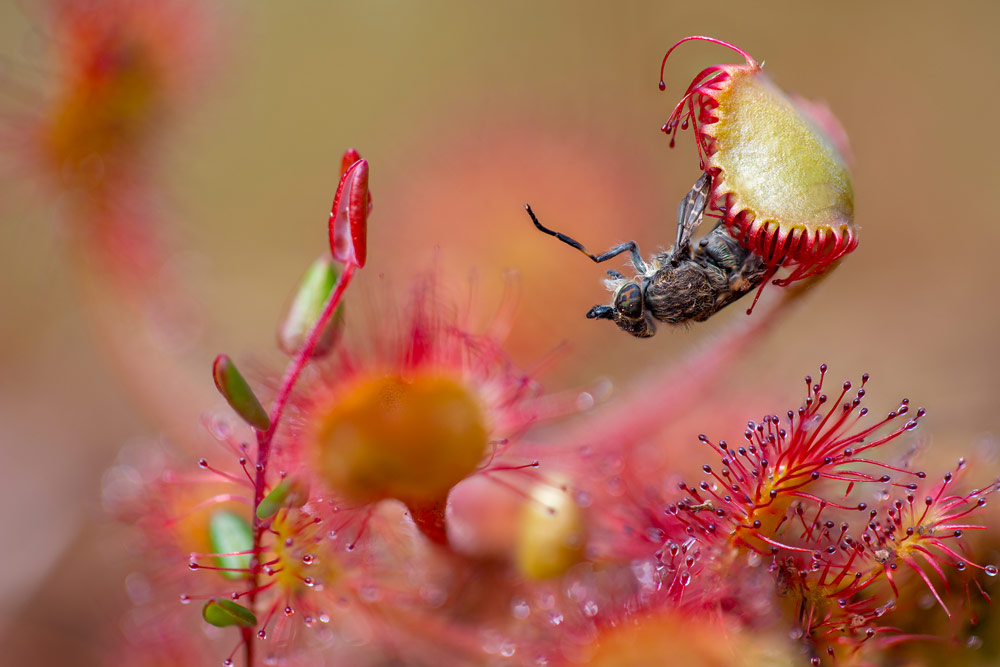
Credit: BWPA/Matt Doogue
Canon 6D Mark II with Canon 100mm f/2.8 Macro lens. 100mm; 1/320th second; f/2.8; ISO 100. Stacked.
A 4:30am alarm to get to Devilla Forest for some early morning butterflies resulted in me finding my first ever Sundew. It was even better that it had prey! Then, when I discovered it had actually snared a horsefly, I was extremely excited. There’s something poetic about the piece: the horsefly, known for biting us, was ‘bitten’ by the Sundew. This is a handheld, stacked image consisting of thirty images to ensure complete focus of the scene.
British Wildlife Photography Awards 2023, Black and White: Winner
Great Mell Fell by Matthew Turner

Credit: BWPA/Matthew Turner
Sony a7R with Sony 16-35mm f/4 lens. 26mm; 1/30th second; f/8; ISO 250.
‘I spent a good few hours on this foggy morning exploring the wooded eastern contours of Great Mell Fell in the Lake District. This is a strange and otherworldly place, with gnarled bark, distorted branches and dank moss everywhere. I clambered through the jumble of fallen trees and eventually stumbled upon this decaying specimen, which to me looked like a claw reaching out from the decomposing pile of tree carcasses beneath. I used my tripod to avoid any camera shake due to the dark and dingy conditions which suited the scene perfectly.’
British Wildlife Photography Awards 2023, Coast and Marine: Winner
Welcome to the Zoo (Plankton) by Henley Spiers

Credit: BWPA/Henley Spiers
Nikon D850 with Nikon 60mm f/2.8 lens. 60mm; 1/60th second; f/29; ISO 2,000.
One night in Shetland, I came face to face with plankton on a scale unlike anything I had experienced before, snorkelling amidst a plankton bloom so thick that, at times, I was unable to see through it. To the naked eye, it looks like a million peach-coloured spheres, as if the contents of a bean bag had spilt over the sea, but my macro lens reveals a mass of tiny organisms. Plankton takes two forms: the first is phytoplankton, which is made up of plants and forms the base of the food chain.
Zooplankton, made up of animals, sits on the next rung up. I am in the midst of the zoo here – a rich tapestry of tiny animals pulsating all around. Some are too microscopic to recognise, but others I can discern. Larval stage crustaceans abound, some swimming through the darkness, others clinging to the life rafts offered by broken-off seaweed. This plankton soup has attracted an army of jellyfish, who feast upon the buffet of miniature life.
British Wildlife Photography Awards 2023, Habitat: Winner
Stag by Loch Shore, Neil McIntyre
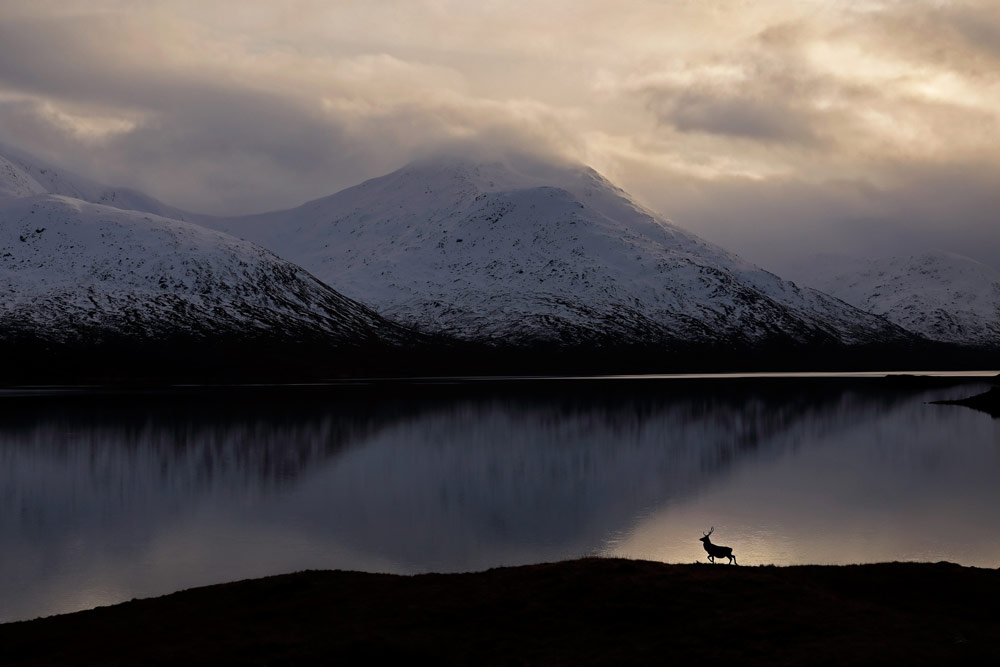
Credit: BWPA/Neil McIntyre
Canon 5D Mark IV with Canon 70-300mm f/4-5.6 lens. 81mm; 1/2,000th second; f/11; ISO 400.
This stunning location is one I visit frequently with the very hope that I might get opportunities just like this. It’s a wide glen with a loch, spectacular mountain backdrops and, of course, the resident deer. On this occasion, I noticed this stag moving along the side of the loch, but I wanted him against a bright patch in the scene. There was just such an area, albeit very small, and he was heading in that direction. I moved into position and waited until he made his way along the ridge; sure enough, he walked right through the light patch.’
British Wildlife Photography Awards 2023, Hidden Britain: Winner
Honey Bee Flight Trail, by John Waters
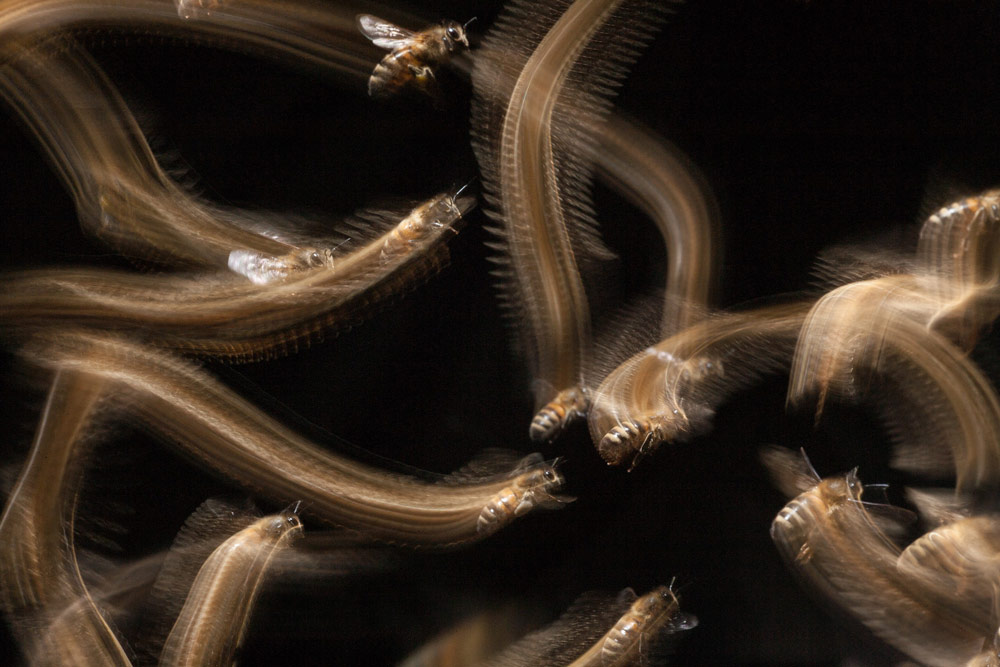
Credit: BWPA/John Waters
Canon 5D with Canon 100mm f/2.8 Macro lens. 100mm; 1/4th second; f/32; ISO 160.
‘Honey bees leave ‘light trails’ as they approach their hive entrance. This shot was taken in a small wildlife-friendly garden in Bristol where my partner keeps bees. I spent hours watching the bees, trying to work out how I could show their comings and goings in a way that would convey a sense of movement – their ‘busyness’. I used a slow shutter speed (0.3 secs) and second-curtain flash to ‘freeze’ the bees after they had made their light trails.’
British Wildlife Photography Awards 2023, Wild Woods: Winner
Mystical Forest, by Phillip Selby
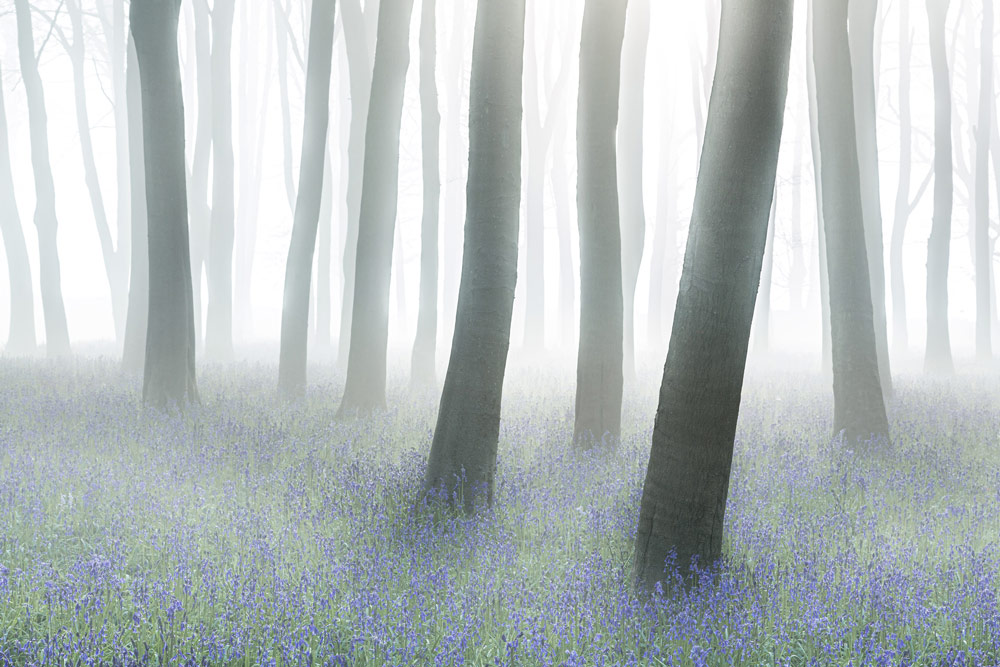
Credit: BWPA/Phillip Selby
Canon 5D Mark III with Canon 24-105mm f/4 lens. 85mm; 1/13th second; f/11; ISO 100.
‘On the remains of an Iron Age hill fort on Badbury Hill in Oxfordshire, Badbury Clump is an area of wonderful beech woodland, carpeted in bluebells each spring. On this particular morning, thick fog had descended, creating a magical, ethereal atmosphere, and it was a wonderful experience to be present in the woods with the camera in hand. Shooting into the light, I was struck by the sense of endlessness as the beech trees eerily dissolved into the silent, misty obscurity.’
Inspired by the winning British Wildlife Photography Awards 2023 photos?
Wildlife and animal photography is a highly rewarding genre and competition success can greatly raise your profile as a photographer. See our complete guide to wildlife photography and if time is of the essence, our guide to mastering animal photography quickly.
See more best photography competitions to enter in 2023
Further reading
How to be an ethical wildlife photographer
Capturing nocturnal animals in low-light photography
How to make a bird photo haven







